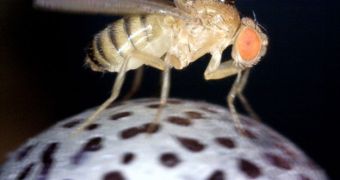A group of physicists, computational scientists and biologists at the Stanford University argue in a new study that a series of phenomena previously thought to be artifacts of normal vision in fact play a very significant role in the way we perceive motion.
The investigation was carried out on fruit flies. The small insects enjoy watching computer screens, and have the tendency to fly in whatever direction they see things on the screen moving. This preference was very important for the team.
Like numerous other animal and insect species, fruit flies detect what scientists refer to as phi motion, a phenomenon that appears when a bright dot, for example, changes its location slightly. Our brains interpret this as motion.
Cartoons, animations and movies are based on this effect. But the team was especially interested in the “reverse-phi” illusion, a phenomenon that involves species perceiving a dark point becoming light as movement away from the initial point of reference, rather than towards it.
For quite some time, scientists believed that reverse-phi motion was simply an artifact created by normal motion vision, and that it played no role in real motion perception. However, the new study demonstrates that this view is wrong, and that the phenomenon is indeed important.
Details of the investigation are published in several scientific papers, which appear in last month's issues of the esteemed journals Neuron and Proceedings of the National Academy of Sciences (PNAS).
“Motion vision is one of the more basic things that our brains can do. Nearly everything that has an eye uses it,” Stanford associate professor of neurobiology and a senior author of the two studies Thomas Clandinin explains.
However, the exact mechanisms involved in allowing the brain to perceive motion are a mystery even in the simple neural circuits of the fruit fly. Experts are especially interested in learning how various areas of the brain communicate in order to correlate changes they are seeing.
“If reverse phi, as unintuitive as it appears, is actually useful to extract motion from visual scenes, then what other structures could be used to help perceive motion?” Clark wonders. Undoubtedly, finding that out will constitute to target of numerous new studies, to be conducted in the future.
The recent studies were supported by a US National Science Foundation (NSF) Integrative Graduate Education and Research Traineeship.

 14 DAY TRIAL //
14 DAY TRIAL //